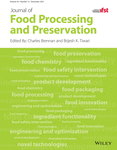Numerical study of large particles flowing in non-Newtonian fluids with nearly neutral buoyancy force
Abstract
The present work investigates the flow of sauce and food particles in food processing by adopting the Eulerian–Lagrangian approach. To account for the large size of the food particles, subroutines were developed to simulate the particle-wall collision and calculate the pressure gradient force. It was found that the particle-wall collision reduces the average and standard deviation of particle residence time. The standard deviation increases as the Stokes number increases. A critical Stokes number of around 2 is identified where the standard deviation increases dramatically. For a constant Stokes number, as the particle size increases, the standard deviation first increases and then decreases. Furthermore, it was found that the inclusion of the pressure gradient force reduces the average and standard deviation of particle residence time. The effects of this force increase as the particle size increases. These results reveal the nonlinear nature of the interactions between the flow and particles.
Practical applications
In food processing applications, a mixture of sauce and food particles is to be dispensed onto the meal tray. To ensure even reheating of the packaged food before serving, it is desired that the food particles should be uniformly distributed on the meal tray. Therefore, understanding the particle residence time distribution inside the dispenser is crucial to the design of the dispensing system. Through numerical investigation, the present work investigates the transport of food particles inside a sauce dispenser. The sauce is modeled as a non-Newtonian fluid. The results reveal the nonlinear nature of the interactions between the flow and particles. Based on these findings, better design of the dispensing system can be achieved.




